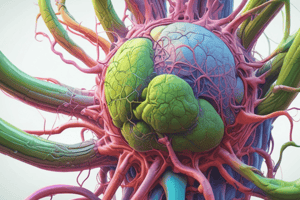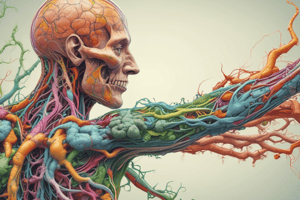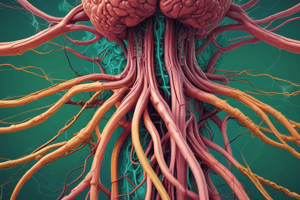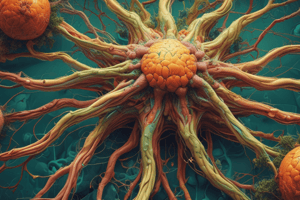Podcast
Questions and Answers
A patient is given an injection of antibodies produced by another individual who recovered from the same illness. What type of immunity is this an example of and why?
A patient is given an injection of antibodies produced by another individual who recovered from the same illness. What type of immunity is this an example of and why?
- Active immunity; because the patient is exposed to a weakened form of the pathogen, stimulating a long-term immune response.
- Passive immunity; because the patient is receiving pre-formed antibodies from an external source, providing immediate but temporary protection. (correct)
- Active immunity; because the patient's own immune system is producing antibodies and the immune system develops immunological memory.
- Innate immunity; because the response is non-specific and does not involve the adaptive immune system.
Which of the following cell types is capable of directly presenting antigens via MHC I?
Which of the following cell types is capable of directly presenting antigens via MHC I?
- Macrophages only
- B cells only
- All nucleated cells (correct)
- Dendritic cells only
Which of the following best describes the role of professional antigen-presenting cells (APCs)?
Which of the following best describes the role of professional antigen-presenting cells (APCs)?
- Directly killing virus-infected cells without the need for T cell activation.
- Presenting antigens on MHC II to activate helper T cells. (correct)
- Activating cytotoxic T cells through MHC I presentation.
- Secreting antibodies to neutralize pathogens in the bloodstream.
A researcher is investigating a new type of immune cell. Initial findings show the cell originates from a lymphoid progenitor and can directly kill infected cells. Which of the following cell types is MOST likely the subject of this research?
A researcher is investigating a new type of immune cell. Initial findings show the cell originates from a lymphoid progenitor and can directly kill infected cells. Which of the following cell types is MOST likely the subject of this research?
What is the primary difference between leukocytes and lymphocytes?
What is the primary difference between leukocytes and lymphocytes?
During a viral infection, a cell displays viral antigens on its MHC I molecules. Which of the following immune cells is MOST likely to recognize and respond to this?
During a viral infection, a cell displays viral antigens on its MHC I molecules. Which of the following immune cells is MOST likely to recognize and respond to this?
A B cell has bound to an antigen and is presenting it on MHC II. What is the NEXT step required to activate this B cell fully?
A B cell has bound to an antigen and is presenting it on MHC II. What is the NEXT step required to activate this B cell fully?
How do Natural Killer (NK) cells recognize and kill infected or cancerous cells?
How do Natural Killer (NK) cells recognize and kill infected or cancerous cells?
Which of the following is NOT a primary function of regulatory T cells?
Which of the following is NOT a primary function of regulatory T cells?
A patient exhibits elevated levels of neutrophils in a blood test. This most likely indicates which condition?
A patient exhibits elevated levels of neutrophils in a blood test. This most likely indicates which condition?
Which characteristic distinguishes erythrocytes from granulocytes?
Which characteristic distinguishes erythrocytes from granulocytes?
What is the primary function of thrombocytes (platelets)?
What is the primary function of thrombocytes (platelets)?
Which of the following cell types is directly involved in allergic and asthmatic responses?
Which of the following cell types is directly involved in allergic and asthmatic responses?
A researcher is studying the immune system and needs cells that can mount a faster and stronger response upon future exposure to an antigen. Which type of cells would be most suitable for this study?
A researcher is studying the immune system and needs cells that can mount a faster and stronger response upon future exposure to an antigen. Which type of cells would be most suitable for this study?
During an experiment, a researcher observes that certain immune cells are releasing toxic reactive oxygen species to kill bacteria. Which type of cells are most likely exhibiting this behavior?
During an experiment, a researcher observes that certain immune cells are releasing toxic reactive oxygen species to kill bacteria. Which type of cells are most likely exhibiting this behavior?
Which of the following cell types are anucleate?
Which of the following cell types are anucleate?
Which of the following is the primary function of plasma cells?
Which of the following is the primary function of plasma cells?
Memory B cells contribute to immunological memory by:
Memory B cells contribute to immunological memory by:
Helper T cells require which of the following interactions to become activated?
Helper T cells require which of the following interactions to become activated?
What is the role of T cell cytokines released by effector helper T cells?
What is the role of T cell cytokines released by effector helper T cells?
Cytotoxic T cells recognize antigens presented on which type of molecule?
Cytotoxic T cells recognize antigens presented on which type of molecule?
How do effector cytotoxic T cells kill target cells?
How do effector cytotoxic T cells kill target cells?
If a patient lacks the ability to produce functional CD4+ T cells, which of the following immune responses would be most severely impaired?
If a patient lacks the ability to produce functional CD4+ T cells, which of the following immune responses would be most severely impaired?
Which feature distinguishes memory cytotoxic T cells from effector cytotoxic T cells?
Which feature distinguishes memory cytotoxic T cells from effector cytotoxic T cells?
What cellular process contributes to the diversity of T-cell receptor (TCR) specificities?
What cellular process contributes to the diversity of T-cell receptor (TCR) specificities?
During T cell development in the thymus, a T cell receptor (TCR) interacts moderately with self-antigens. According to the selection processes, what type of T cell is MOST likely to result from this interaction?
During T cell development in the thymus, a T cell receptor (TCR) interacts moderately with self-antigens. According to the selection processes, what type of T cell is MOST likely to result from this interaction?
A developing T cell in the thymus interacts strongly with MHC class I molecules. What is the MOST likely outcome for this T cell?
A developing T cell in the thymus interacts strongly with MHC class I molecules. What is the MOST likely outcome for this T cell?
What is the PRIMARY mechanism by which antibodies facilitate the destruction of pathogens?
What is the PRIMARY mechanism by which antibodies facilitate the destruction of pathogens?
An antibody's ability to bind to a specific antigen is primarily determined by what region of the antibody structure?
An antibody's ability to bind to a specific antigen is primarily determined by what region of the antibody structure?
A B cell initially secretes IgM antibodies. Upon activation by a helper T cell and exposure to specific cytokines (interleukins), it begins to secrete IgG antibodies instead. What process has occurred?
A B cell initially secretes IgM antibodies. Upon activation by a helper T cell and exposure to specific cytokines (interleukins), it begins to secrete IgG antibodies instead. What process has occurred?
Which component of the immune system is composed of serum proteins that enhance other immune defenses?
Which component of the immune system is composed of serum proteins that enhance other immune defenses?
A researcher is studying the function of different antibody isotypes during a parasitic infection. They observe that a particular antibody isotype is highly effective at activating mast cells and basophils to release inflammatory mediators. Which antibody isotype BEST corresponds to this function?
A researcher is studying the function of different antibody isotypes during a parasitic infection. They observe that a particular antibody isotype is highly effective at activating mast cells and basophils to release inflammatory mediators. Which antibody isotype BEST corresponds to this function?
Which of the following accurately describes the role of C3b in the complement system?
Which of the following accurately describes the role of C3b in the complement system?
How does the membrane attack complex (MAC) contribute to the complement system's function?
How does the membrane attack complex (MAC) contribute to the complement system's function?
Interferons exert their antiviral effects through which of the following mechanisms?
Interferons exert their antiviral effects through which of the following mechanisms?
Which of the following is NOT a macroscopic sign of inflammation?
Which of the following is NOT a macroscopic sign of inflammation?
Which of the following is the primary role of interferon-gamma in the interferon response?
Which of the following is the primary role of interferon-gamma in the interferon response?
Which of the following events initiates the inflammatory response?
Which of the following events initiates the inflammatory response?
What is the role of complement protein C3a in the immune response?
What is the role of complement protein C3a in the immune response?
Histamine release during inflammation directly contributes to which of the following macroscopic signs?
Histamine release during inflammation directly contributes to which of the following macroscopic signs?
Which of the following cell types is primarily responsible for mediating allergic responses through the release of histamine, leading to local blood vessel dilation?
Which of the following cell types is primarily responsible for mediating allergic responses through the release of histamine, leading to local blood vessel dilation?
A patient presents with a suspected parasitic infection. An elevated count of which type of granulocyte would most likely support this diagnosis?
A patient presents with a suspected parasitic infection. An elevated count of which type of granulocyte would most likely support this diagnosis?
Which of the following cell types functions as a professional antigen-presenting cell (APC) and is also involved in phagocytosing pathogens?
Which of the following cell types functions as a professional antigen-presenting cell (APC) and is also involved in phagocytosing pathogens?
Which of the following cells is a precursor to macrophages?
Which of the following cells is a precursor to macrophages?
Dendritic cells play a crucial role in initiating adaptive immune responses. How do they contribute to this process after encountering pathogens?
Dendritic cells play a crucial role in initiating adaptive immune responses. How do they contribute to this process after encountering pathogens?
Which of the following represents a component of the adaptive immune system?
Which of the following represents a component of the adaptive immune system?
Which of the following cell types is NOT involved in innate immunity?
Which of the following cell types is NOT involved in innate immunity?
Which cell type utilizes granzyme and perforin to induce apoptosis in infected or cancerous cells?
Which cell type utilizes granzyme and perforin to induce apoptosis in infected or cancerous cells?
What is the primary function of platelets in the blood?
What is the primary function of platelets in the blood?
In the context of the immune system's lines of defense, which of the following exemplifies the first line of defense?
In the context of the immune system's lines of defense, which of the following exemplifies the first line of defense?
Which of the following is a characteristic of the third line of defense in the immune system?
Which of the following is a characteristic of the third line of defense in the immune system?
Which cell type matures in the thymus and plays a critical role in activating B cells and killing infected cells?
Which cell type matures in the thymus and plays a critical role in activating B cells and killing infected cells?
How do neutrophils contribute to the innate immune response against bacterial infections?
How do neutrophils contribute to the innate immune response against bacterial infections?
Mast cells and basophils both release histamine, but what is a key difference in their location within the body?
Mast cells and basophils both release histamine, but what is a key difference in their location within the body?
What role does the mucociliary escalator play as part of the immune system?
What role does the mucociliary escalator play as part of the immune system?
Flashcards
Passive Immunity
Passive Immunity
Immunity gained from antibodies from another source, like breastfeeding or antibody injection.
Antigen Presenting Cells (APCs)
Antigen Presenting Cells (APCs)
Cells that present antigens on MHC I to cytotoxic T cells; all cells are APCs.
Professional APCs
Professional APCs
Cells that present antigens on MHC II to helper T cells; includes B cells, macrophages, dendritic cells.
Leukocytes
Leukocytes
Signup and view all the flashcards
Lymphocytes
Lymphocytes
Signup and view all the flashcards
Natural Killer (NK) Cells
Natural Killer (NK) Cells
Signup and view all the flashcards
B Cells
B Cells
Signup and view all the flashcards
Clonal Expansion
Clonal Expansion
Signup and view all the flashcards
Plasma Cells
Plasma Cells
Signup and view all the flashcards
Memory B Cells
Memory B Cells
Signup and view all the flashcards
Helper T Cells (CD4+)
Helper T Cells (CD4+)
Signup and view all the flashcards
Cytotoxic T Cells (CD8+)
Cytotoxic T Cells (CD8+)
Signup and view all the flashcards
E ector Helper T Cells
E ector Helper T Cells
Signup and view all the flashcards
Memory Cytotoxic T Cells
Memory Cytotoxic T Cells
Signup and view all the flashcards
Reserve Immune Cells
Reserve Immune Cells
Signup and view all the flashcards
Regulatory T Cells
Regulatory T Cells
Signup and view all the flashcards
Myelocytes
Myelocytes
Signup and view all the flashcards
Erythrocytes
Erythrocytes
Signup and view all the flashcards
Thrombocytes
Thrombocytes
Signup and view all the flashcards
Granulocytes
Granulocytes
Signup and view all the flashcards
Neutrophils
Neutrophils
Signup and view all the flashcards
Eosinophils
Eosinophils
Signup and view all the flashcards
TCR Variable Region
TCR Variable Region
Signup and view all the flashcards
Negative Selection
Negative Selection
Signup and view all the flashcards
Positive Selection
Positive Selection
Signup and view all the flashcards
Goldilocks Selection
Goldilocks Selection
Signup and view all the flashcards
Opsonization
Opsonization
Signup and view all the flashcards
Antibody Structure
Antibody Structure
Signup and view all the flashcards
Class/Isotype Switching
Class/Isotype Switching
Signup and view all the flashcards
Complement System
Complement System
Signup and view all the flashcards
Complement Protein Functions
Complement Protein Functions
Signup and view all the flashcards
Cytotoxicity
Cytotoxicity
Signup and view all the flashcards
Inflammation
Inflammation
Signup and view all the flashcards
Interferons
Interferons
Signup and view all the flashcards
Self Destruction in Immunity
Self Destruction in Immunity
Signup and view all the flashcards
Recruiting Phagocytes
Recruiting Phagocytes
Signup and view all the flashcards
Histamine Release
Histamine Release
Signup and view all the flashcards
Basophils
Basophils
Signup and view all the flashcards
Mast Cells
Mast Cells
Signup and view all the flashcards
Macrophages
Macrophages
Signup and view all the flashcards
Monocytes
Monocytes
Signup and view all the flashcards
Dendritic Cells
Dendritic Cells
Signup and view all the flashcards
First Line of Defence
First Line of Defence
Signup and view all the flashcards
Second Line of Defence
Second Line of Defence
Signup and view all the flashcards
Third Line of Defence
Third Line of Defence
Signup and view all the flashcards
Platelets
Platelets
Signup and view all the flashcards
Red Blood Cells
Red Blood Cells
Signup and view all the flashcards
Study Notes
Lymphatic System Functions
- The lymphatic system is an open network, unlike the circulatory system.
- It drains excess interstitial fluid (lymph) from capillary beds, preventing blood volume loss.
- Lymph is returned to systemic circulation via the subclavian vein.
- Valves in lymphatic tubules prevent backflow.
- Lymph nodes contain immune cells (B and T cells) to mount an immune defense.
- Lymph vessels called lacteals absorb fats from the small intestine.
Lymphatic Tissue
- Primary lymphatic tissue includes:
- Thymus: T cell maturation site
- Spleen: Filters blood, houses immune cells
- Lymph nodes: Collect lymph, house immune cells
- Secondary lymphatic tissue (MALT) is lymphoid tissue in various locations like tonsils, appendix, etc.
Pathologies
- Lymphedema: Swelling due to insufficient fluid drainage by the lymphatic system.
Immune System Types
- Components categorized as humoral (body fluids) or cell-mediated (leukocytes).
- Innate immunity is non-specific and includes physical barriers, chemicals, and non-specific cells.
- Adaptive immunity is specific and includes B and T cells.
- Active immunity develops after exposure to an antigen, while passive immunity is acquired from another source.
Cells of the Blood
- Antigen-presenting cells (APCs) present antigens on MHC molecules to other immune cells.
- Professional APCs include B cells, macrophages, and dendritic cells.
Lymphocytes
- A category of cells including B cells, T cells, and NK cells, originating from a common lymphoid progenitor.
- Natural Killer (NK) cells destroy infected or cancerous cells.
- B cells produce antibodies, mature in the bone marrow, and are professional APCs. Plasma cells produce antibodies. Memory B cells provide immunological memory.
- T cells have T cell receptors (TCRs) and mature in the thymus. Helper T cells activate immune responses. Cytotoxic T cells kill infected or cancerous cells. Memory T cells provide immunological memory.
Myelocytes
- A category including red blood cells, platelets, granulocytes, and macrophages.
- Erythrocytes (red blood cells) carry oxygen.
- Thrombocytes (platelets) are involved in blood clotting.
- Granulocytes (neutrophils, eosinophils, basophils) are phagocytic cells involved in immune response. Neutrophils are the most numerous leukocytes and are frequently the first responders to inflammation. Eosinophils are involved in allergic and asthmatic responses, and basophils release histamine.
- Macrophages, monocytes (precursors) are phagocytic and professional APCs, while dendritic cells interact with external environment at tissues (skin, lungs, etc.)
Immune System Defenses
- Innate immunity involves physical barriers, non-specific cells, and chemical responses.
- Adaptive immunity involves specific B and T cells and immunological memory.
Interferon Response
- Interferons are antiviral cytokines secreted by infected cells, triggering self-destruction, warning neighboring cells, and recruiting phagocytes.
Inflammatory Response
- The inflammatory response is a combination of events that occur in response to pathogen invasion, cellular damage or irritants. It involves macroscopic signs like redness, swelling, heat and loss of function, plus microscopic signs like histamine release, vasodilation, and phagocyte recruitment.
Pathologies
- Regulatory T cell pathologies include susceptibility to cancer or autoimmune disorders, depending on levels of T-cell regulation.
- Acquired Immunodeficiency Syndrome (AIDS), Type I Diabetes, Rheumatoid Arthritis, Lupus, Inflammatory Bowel Disease, Hashimoto's Thyroiditis and Asthma are examples of autoimmune diseases.
Studying That Suits You
Use AI to generate personalized quizzes and flashcards to suit your learning preferences.




